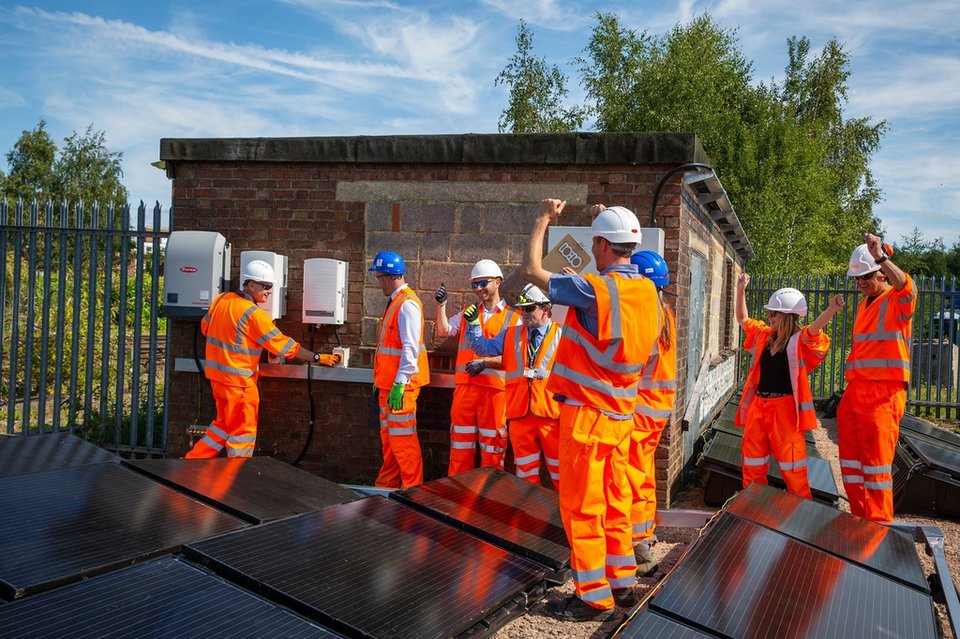All images: Max Bögl
Environmental
The sunny side of rail: Riding Sunbeams
The rail industry has been making strides to further improve its impressive green credentials. UK-based company Riding Sunbeams is working towards harnessing the power of the sun for sustainable rail power. Frankie Youd speaks to company director Leo Murray to find out how.
Rail has been noted to be one of the cleanest, greenest modes of transport and is showing no signs of slowing down when it comes to reducing its CO2 and harmful gas emissions. Companies such as Alstom are taking centre stage with hydrogen-powered trains, as well as Wabtec announcing battery-electric powered freight locomotives.
Alongside these alternative fuel types, a UK-based company, Riding Sunbeams, is turning to the sky to harness the power of the sun as an alternative fuel for rail. We speak to Leo Murray, director of Riding Sunbeams, to find out more about the key benefits of solar-powered rail and the future of the project.
British Transport Police Superintendent Andrew Morgan


Aerial view of the Aldershot solar array. Credit Riding Sunbeams
Frankie Youd: Could you provide some background on Riding Sunbeams?
Leo Murray: Riding Sunbeams began in 2017 as an innovation project by the climate charity Possible and Lewes-based Community Energy South. It was formally constituted in 2018 as a business with a mission to find an unsubsidised route to market for community energy, and to rapidly decarbonise railways in a way that maximises social benefit.
Britain’s railways are our largest electricity consumer. With demand spread across thousands of kilometres of track, they need access to zero-carbon energy sources to be able to fully transcend fossil fuels.
Solar subsidies have been scrapped, and much of the UK power grid is at capacity so cannot accept new connections from solar generators. This means that to secure the capital investment to build new solar panels in Britain, developers need direct access to financially secure, large-scale energy users who are capable of signing long term power purchase agreements to buy all the energy generated by the solar farm over its lifetime.
Railways and solar panels are therefore a match made in heaven.
Railways and solar panels are therefore a match made in heaven. Direct supply of solar power to rail traction systems has never been done in the UK before. But it has huge potential for metros, trams, and railways in the UK and around the world.
It began with Possible (then known as 10:10 climate action) bringing together experts from the Energy Futures Lab at Imperial College London, Community Energy South, and electrical engineering specialists Turbo Power Systems to find out if the idea of powering the railways with trackside solar panels was technically and commercially feasible. After extensive analysis, we confirmed that it was.
Our research shows that solar traction power could provide at least one-tenth of the energy needed to power trains on the UK’s electrified routes every year. Our aim is to develop a network of community and commuter-owned solar farms to power the railways – for the benefit of the railway routes, the communities that host them, and of course the planet.
How would the technology of powering rail with solar work, what infrastructure would need to be put in place?
Solar panels can be installed either on rooftops or on land near the train tracks, with a direct wire connection to feed the track with DC current, bypassing the electricity grid completely.
Our pilot project at Aldershot station was installed adjacent to the line and consisted of 123 solar modules, with a total capacity of 36.9 kilowatts peak.
To minimise the cost and lead time and avoid any works on the railway high voltage network, the project back-fed the AC feeders to the traction system using an existing 33kV to 400V step-down transformer as the point of connection. These are common across Network Rail’s Southern region and therefore provide many connection points for future arrays.
The next phase is our Selmeston Solar Rail Connection project: a 4MW solar farm in Berwick, next to an operational solar farm. It lies north of the Eastbourne–London mainline railway, which will be powered by the energy it generates. A 3.7km cable will run from the solar farm to the railway, almost entirely underground, and mainly installed below existing roads. The point of connection will be at the Selmeston Network Rail Substation.
Having proved we can safely and efficiently connect solar to the DC electrified railways, we’re now working on the technology for a converter that would allow us to connect solar power into the AC electric rail network too.
Although there are existing power electronics in use on the rail network that could provide the conversion needed, these solutions are over-engineered and too expensive to support the solar-to-rail use case. Our bespoke ‘Daybreak’ converter will unlock AC networks in Britain and beyond, to private wire supply direct from solar generators for the first time.
What are the main benefits of using solar energy for rail?
The urgent need to tackle the climate emergency and decarbonise our energy and transport systems has become a political and industrial imperative, with the government launching its Net Zero strategy in October, closely followed by the COP26 global conference in Glasgow.
Network Rail is the single biggest user of electricity in the UK – accounting for 1% of total demand – and is also committed to achieving net-zero by 2050. Most of its carbon emissions currently arise from traction energy in the form of diesel fuel and grid-supplied electricity.
Widespread constraints on the UK’s electricity grids are acting as a barrier to further build-out of solar farms, but the railways can offer an attractive alternative route to market for developers.
The Selmeston project will save 820 tonnes of CO2 a year. It can also make an already green form of transport even greener – electric trains that run on renewable electricity have a carbon footprint almost one hundred times lower than diesel trains – and engage commuters directly with the need to get to net-zero, including through the opportunity to invest in these new sources of traction power.
The rail network will also be able to procure green electricity at scale and at a competitive price, helping future-proof rail travel against energy price inflation and volatility – a particular concern at the moment as rising gas prices are causing power prices to increase too.
Community ownership of the solar projects powering the railways will create profits that can be used to fund local projects that support the vulnerable and further promote the low-carbon transition.

Aerial view of the Aldershot solar array. Credit: Riding Sunbeams
Why do you feel that solar has not been implemented until this point?
Solar power is one of the biggest success stories so far when it comes to tackling the climate crisis. It is the incredible drop in prices per kilowatt-hour of this energy source over the past decade that has made solar an attractive option for traction power.
Until recently, new solar generation had to rely on government subsidies to underwrite investment, and that meant connecting to the grid. Solar is now the cheapest new energy generation technology, alongside onshore wind – but most electrified rail uses AC, and no products exist on the market today which can feed solar power directly into traction systems at a suitable price point. We are working with our partners to fix this!
It is also the case that UK railways are one of the most heavily regulated business operating environments in the world, with institutional and regulatory inertia that makes them difficult to penetrate for SMEs with innovative value propositions.
However, after putting in a lot of time and effort, we have been working collaboratively and successfully with staff from across Network Rail, from route asset management, sustainability and decarbonisation, commercial partnerships, energy procurement, innovation, and systems operation to develop our unique proposition.
When does the company hope that solar power rail will be implemented into day-to-day life?
We plan to begin the construction of the Cuckmere solar farm in 2022. This is usually quite quick and should take about three months, so we aim for the Selmeston project to be exporting power directly to the railway track by later next year.
Once we have Selmeston up and running, we expect it to pave the way for many more similar projects. Our work has already informed Network Rail’s Traction Decarbonisation Network Strategy as well as the Department for Transport’s Transport Decarbonisation Strategy, and Riding Sunbeams was included in the UK government’s Net Zero Strategy announced in October as a best practice case study in community energy.
We are working on a pipeline of other solar traction projects and after we have delivered Selmeston, our first priority will be to connect up to 200MW of new solar to the Southern Region, saving over 80,000 tonnes of CO2 per year.
We hope that solar-powered rail will become part of many people’s day to day life within a few years.
We also recently completed a new feasibility study with Transport for Wales for direct supply to 25kV AC overhead electrified routes, looking at the potential for community solar to power the South Wales Metro. We are also exploring projects with Mersey Travel, Transport for London, and High Speed 1 – and have had some very productive early-stage meetings with overseas rail operators too, some of them in countries with a lot more sunshine than the UK.
We hope that solar-powered rail will become part of many people’s day to day life within a few years, when people can travel by train knowing not only that they have chosen the lowest carbon form of long-distance travel but that they own a part of the infrastructure that is powering their journey.
Solar is the nation’s favourite energy source by a large margin. Railways were invented by the British, and they still hold a central place in our national identity.
Pre-Covid-19, British people made over eight billion commuter journeys by rail annually, and rail travel is starting to pick up again post-pandemic. The view from the train window is indelibly etched into the British cultural psyche, making such vistas ideal places to put solar panels and get people on board with a net-zero future.
Main Image: Riding Sunbeams director, Leo Murray. Credit: Riding Sunbeams